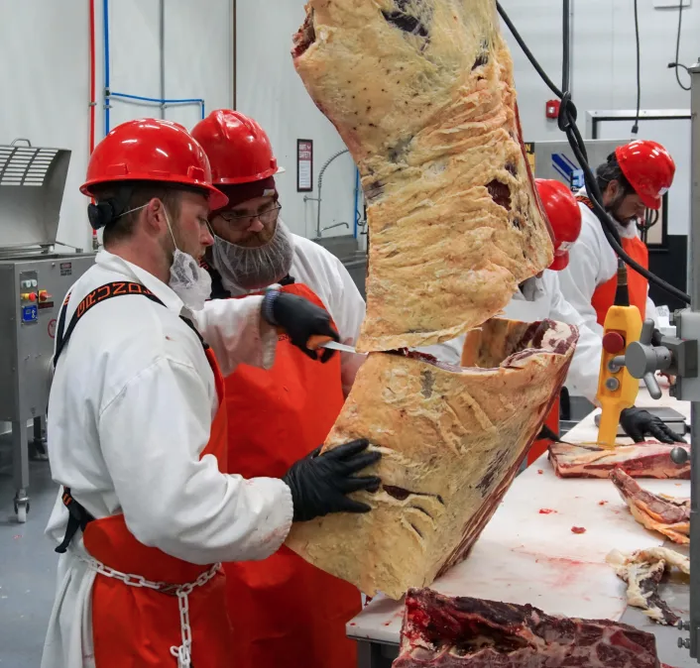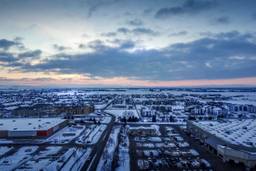Oklahoma Tribes Are Fighting Corporate Consolidation of the Cattle Industry—and Building Food Sovereignty
“Food is power, and having control over your food sources is the difference between independence or subjugation.”
Ben Felder

Editor’s Note: This story was originally published on Investigate Midwest.
HOMINY, OKLA.— Cole McKinney leapt onto the edge of a metal fence and began banging its side, trying to spook a nearly 700-pound bison into turning around inside its pen. But the bison repeatedly lowered its horned head into the fence, resisting McKinney’s order to face the other way.
“This part’s not easy,” said McKinney, the plant manager at Butcher House Meats, a 19,000-square-foot meat processing facility in Hominy, Oklahoma. Owned and operated by the Osage Nation tribal government, the plant processes mostly bison and cattle.
After about 10 minutes of jumping along the side of the pen, McKinney finally got the bison to turn around and head through a chute leading inside the plant’s back door.
“Cows are easier because they will often go right in,” McKinney said. “Bison have their own spirit.”
Built in 2021, the facility’s 10 employees slaughter and package animals for dozens of ranchers in this part of northeast Oklahoma, where cattle mostly scatter along the rolling prairies or clump around its winding creeks. The plant also processes cows and bison from the Osage Nation’s own ranch, with some of the meat sold in a store at the front of the building.
The Osage Nation’s plant is a source of food and employment in this rural community but it’s also an attempt to reverse a multi-decade trend of small and medium-sized meat packing plants closing in response to a consolidating cattle industry.

Today, cattle ranchers across the country have fewer processors to sell to, which many say has deflated their profits. Those who have tried to remain independent often don’t have a small meatpacker nearby to do business with.
But the impact of consolidation has been especially jarring in America’s tribal communities, where the rate of plant closures has exceeded the national average.
Since 1990, beef processing plants on America’s tribal lands and reservations have closed at nearly double the rate of the national average, according to data from the USDA’s Food Safety and Inspection Service, which monitors meat, poultry and egg production sites.
In Oklahoma, which ranks second in the nation for beef cow inventory and second (behind Alaska) in the percentage of Native American residents, 60% of the cattle processing plants that have closed since 1990 were in the state’s tribal areas.
From 1980 to 2022, the number of all animal processing facilities in Oklahoma declined from 201 to 82, with more than 70% of those closed plants located in tribal areas, according to the USDA’s Livestock Slaughter Annual Summary report.
The USDA currently inspects 722 beef processing facilities across the country, less than half the number of plants that were open in 1980. Today, just 28 cattle processing plants are within tribal lands. Nearly two-thirds of those plants are in Oklahoma.
“There is in this region and in this country far too little capacity for meat processing, and it’s in the hands of far too few people and far too few corporations,” said Chuck Hoskin, the principal chief of the Cherokee Nation, which opened its own meat processing facility in Tahlequah, Oklahoma, in 2022.
Over the past four years, the Osage, Cherokee and Muscogee (Creek) nations have opened USDA-inspected processing plants in eastern Oklahoma, joining the Quapaw Nation, which opened its own facility seven years ago. Another tribe, the Choctaw Nation, has invested in a recently opened facility in southern Oklahoma.
Supply chain challenges during the early months of COVID-19 inspired many of the tribes to build their own plants, and some used federal pandemic relief funds for initial construction. Using cattle and bison from their own ranches, the tribes are processing meat to supply their daycare centers, senior homes and hotels, as well as some low-income meal programs they operate with federal funding.
However, each plant also processes meat for area ranchers, offering custom cuts and packaging services that have not existed in some communities for many years.
“A lot of ranchers around here were having to travel 40 or 50 miles to get to the nearest processors, but since opening, we have cut down that drive for a lot of ranchers in the area,” said Adrian Sinclair, the plant manager at 1839 Cherokee Meat Co., the Cherokee Nation’s plant named after the year it formed its constitution. “We are hearing all the time how this (facility) has eased diesel costs and reduced the stress on the animal by not traveling quite as far.”
Some Cherokee ranchers raising cattle just for their own family’s consumption started commercial operations because the new USDA-inspected facility was close enough to be cost-effective.
“This plant made it easier to (produce) cows because closer is
better, closer is cheaper,” said Jill Hough, a Cherokee citizen whose
family began processing its herd at the Cherokee Nation’s facility.
According to 2022 USDA figures, bison and beef make up the largest agricultural sector for Native American communities nationwide, accounting for 39% of all Indian agriculture production.
Operating a meat processing facility can give tribal governments more control over their cattle industries, said Chris Roper, a technical assistance director with the Flower Hill Institute, a nonprofit that works with tribes on food sovereignty issues.
Roper once worked for the Quapaw Nation, an Oklahoma tribe that built a meat processing plant in 2017. At the time, it was one of the few tribal-owned facilities in the country. Today, he estimates there are at least 12.
“But there are about a dozen others that are currently working on a new plant that hasn’t opened yet,” said Roper, who helps tribes across the country plan and build meatpacking facilities. “I think there is a lot of momentum around this, and I project that over the next five years, there will be 50-plus (tribal-owned) plants.”
Forced into Oklahoma, tribes built a cattle industry
After being forced to relocate from Kansas to present day northern Oklahoma in the late 1800s, the Osage people struggled to grow crops on their new land. However, its high-nutrient grass made it a prime stop for cattle drives on the way from Texas to the stockyards of Kansas City.
By 1898, the Osage Nation leased more than 431,000 acres to cattle drivers and later raised its own herds, creating a burgeoning livestock industry that attracted new railroad lines.
“Arguably, without Osage grass leases, Oklahoma’s modern economy may not have reached its admirable level since fewer homesteaders and businesses would have been able to settle there due to a lack of available transportation,” wrote Athena Stephanopoulos in her 2007 research paper, “How the Cows Came Home… as Dinner,” a history on the Osage cattle industry.
Other tribes followed with their own cattle operations, but the growth in white homesteaders led to the depletion of land suitable for grazing.
Before the end of the 19th century, the United States forced tribes in present-day western Oklahoma to give up 2 million acres of their cattle grazing land to white settlement.
The loss of land for some tribes increased demand for others, including the Osage, whose cattle grazing leases topped 720,000 acres by 1910.
Over the next several decades, cattle remained a prominent economic engine in the Osage Nation, whose land became home to some of the state’s largest ranches, including a few owned by non-Osage citizens.
But by the second half of the 20th century, America’s cattle industry was beginning to shift to one dominated by just a handful of producers who built large facilities that often squeezed out smaller packers and limited where ranchers could sell their cows.
In 1977, 84% of cattle in America were slaughtered in processing plants that handled fewer than half a million animals a year. By 1997, those plants were processing just 20% of the nation’s cattle, according to a USDA report on meatpacking consolidation.
That consolidation push was led by four companies — Tyson Foods, Cargill, National Beef Packing Company, and JBS — that now slaughter about 70% of the nation’s steers and heifers.
Large slaughter plants were built in western Kansas, eastern Colorado and the Texas Panhandle, which continued to make western Oklahoma a prime cattle ranching region, especially for large feedlots that fatten cattle just before processing. However, that geographic center moved further away from eastern Oklahoma, where most of the state’s tribal communities are located.
In Osage County, which is also the boundary for the Osage Nation reservation, annual cattle production from 1970 to 2017 declined by more than 19%, while statewide numbers increased by 3% during the same time, according to USDA figures.
Of the Oklahoma counties with a cattle population decline of at least
10%, the vast majority are within tribal reservation boundaries.
Roper, the director with the Flower Hill Institute, said consolidation has also increased the likelihood of supply chain challenges for tribal communities, along with hurting the small ranchers who run their own retail businesses.
“These (tribal) communities realized that they can’t rely on the consolidated industry and these big plants to keep the stores filled because at some point that supply chain is going to break down,” said Roper, pointing to the pandemic as an example.
Workforce training and more funding needed, tribal advocates say
Sinclair, the plant manage at the Cherokee Nation’s meat processing facility, walked past a line of hanging beef carcasses inside a refrigerated room but his eyes studied the floor for any meat scraps or other loose items.
“I take sanitation very seriously,” Sinclair said with a laugh. “But I’m proud of how clean we keep this facility, very proud.”
In the next room, a team of five employees wearing orange aprons broke down a cut of beef, including one worker on a band saw who sliced through a rib section. In another room, two workers used a machine to grind beef chunks into hamburger patties.

Fourteen people work at the plant, most of whom are Cherokee citizens, according to Whitney Dittman, a spokesperson for the tribe.
During the first three months of 2024, the plant processed about 45 cows for independent ranchers in the area, along with 14 sheep and 16 hogs. The plant also processed more than 46 cows from the Cherokee Nation’s own ranch.
The numbers are small compared to facilities owned by one of the four major packing companies. Plants operated by Tyson and National Beef in southwest Kansas each slaughter 6,000 head of cattle a day.
But the Cherokee Nation’s meat facility has enough capacity to supply 15,000 pounds of ground beef and 3,600 pounds of roast each month to the Cherokee Nation’s several food distribution sites across a 14-county region.
Dittman said processing its own meat helped the Cherokee Nation stretch further a $10 million USDA grant to address food insecurity in tribal communities.
“Having this facility allows us to produce the protein that we would normally have to go out and buy from somewhere else,” Dittman said. “It’s come full circle with Cherokees producing their own protein for other Cherokees.”
Advocates for more tribal-owned meat processing facilities say it can enhance the numerous federal food assistance programs operated by tribes and offer more locally produced meat to users of the Supplemental Nutrition Assistance Program, what some call food stamps.
Nationwide, one in four Native Americans use federal food assistance programs, according to the Native Farm Bill Coalition.
The federal government provides some funding to help tribes build and expand plants but recent demand has exceeded those amounts.
Last year, 67 tribes applied for more than $350 million in funding through the Indigenous Animals Harvesting and Meat Processing Grant Program, which had just $50 million in grants to award, according to the Flower Hill Institute.
Several indigenous agriculture groups have pushed for Congress to add more support for tribal-led meat production in the next Farm Bill, not just through grants but also access to credit.
“Congress should ensure that loan and loan guarantee opportunities are available for the development of meat, poultry, fish, and seafood processing facilities in Indian Country,” the Native Farm Bill Coalition, a group advocating for federal policies, argued in its 2022 “Gaining Ground” report. “Access to credit will assist Tribal communities in developing regional food systems and support tribal member access to traditional, affordable, and nutritional sources of protein.”
Abi Fain, chief legal and policy officer for the Intertribal Agriculture Council, said the federal government should also look for ways to increase training for meatpacking jobs and USDA inspectors, especially since it can be hard to fill positions in rural communities, where many tribes are located.
“If you are in Muscogee you may only be 30 minutes from Tulsa,” said Fain, referring to the location of Muscogee (Creek) Nation’s meat processing center, Looped Square Meat Company, located about 25 miles south of the state’s second-largest city. “But in other parts of Indian country that is not the case. In some tribes in South Dakota you may be two hours from the nearest city or nearest town.”
Fain said she expects the number of tribal-run meat packing plants to increase, even among tribal communities that have not traditionally been involved in agriculture production.
Gaining more control over local food systems is enticing for tribes when they see the success others are having, she added.
“Food is power,” Fain said, “and having control over your food sources is the difference between independence or subjugation.”
Investigate Midwest is an independent, nonprofit newsroom. Our mission is to serve the public interest by exposing dangerous and costly practices of influential agricultural corporations and institutions through in-depth and data-driven investigative journalism.Visit us online at www.investigatemidwest.org
Ben Felder covers agribusiness and the meat industry in Oklahoma for Investigate Midwest. Felder previously worked for The Oklahoman as a political enterprise reporter blending narrative storytelling, data analysis and investigative reporting to cover the state’s political leaders, the influences behind them, and their impact on everyday Oklahomans. Originally from Kansas City, Missouri, and a graduate of Trevecca University in Nashville, Felder lives in Oklahoma City with his wife, Lori, and son, Satchel.





